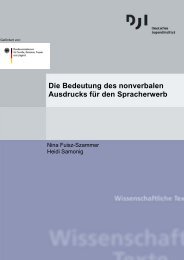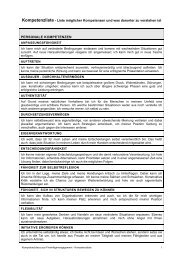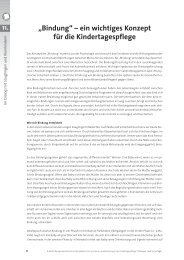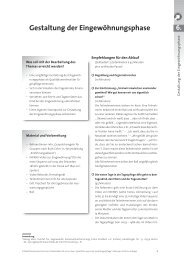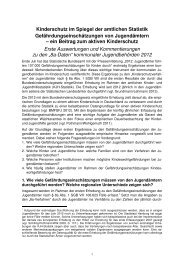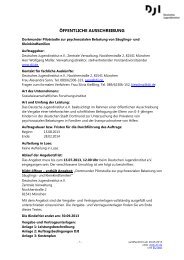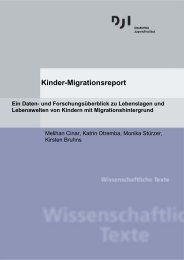download - Deutsches Jugendinstitut e.V.
download - Deutsches Jugendinstitut e.V.
download - Deutsches Jugendinstitut e.V.
Create successful ePaper yourself
Turn your PDF publications into a flip-book with our unique Google optimized e-Paper software.
anomic developments and, secondly, structural deficits of social disorganisation. This<br />
includes for instance the low intensity of social networks and the lack of participation<br />
and/or lack of controlling impulses governing the activities of groups of young persons.<br />
Eisner (1997) augmented previous models to form a process-related model: urban areas<br />
which are considered to be unsafe by local inhabitants – and these particularly include rundown,<br />
amorphous or inhospitable spaces – trigger off the phenomenon of retreat which in<br />
turn leads to selective segregation and social control primarily oriented towards selfinterests<br />
on the part of the individual remaining groups. Segregation therefore manifests<br />
itself as both the development and consolidation of social inequality (Dangschat 2000).<br />
Coherence of urban segregation types and integration or disintegration<br />
impulses<br />
There follows an examination of the diverse segregation types existing in urban centres in<br />
Germany and what impulses these types have on the integration process of immigrant<br />
families and their children.<br />
As a rule, there are eight types of segregation areas (cf. Kilb 1998) found within densely<br />
populated areas which differ according to specific infrastructural, architectural and/or<br />
economic-historical features:<br />
a) residential areas in city and peripheral city areas with imminent or anticipated<br />
changes in utilisation (characteristics: high noise and environmental pollution, high<br />
proportion of immigrants, transitional habitation and confrontation between<br />
accumulation of consumption and poverty);<br />
b) Sub-central core areas with less pronounced but comparable structures as in a);<br />
c) Districts adjacent to traffic hubs and major traffic routes (high noise, dirt and<br />
environmental pollution; concentration of immigrants and transitional habitation<br />
areas)<br />
d) Traditional industrial and working-class residential areas (the link of common<br />
workplaces is constantly weakening);<br />
e) Large-scale council house estates from the 1920s, 1950s und 1960s;<br />
f) Satellite town areas/large-scale estates from the 60s und 70s (residential<br />
segregation);<br />
g) Solitary high-rise buildings and mass housing concentrated at specific points<br />
(hostels, homeless shelters, accommodation for re-settlers and asylum seekers);<br />
h) Traditional segregated housing (housing for the homeless and itinerants, caravan<br />
parks, trailer and container parks).<br />
Segregation types and their effects on inhabitants<br />
These eight types of segregation areas can in turn be assigned to one of four different<br />
“effect types” on the strength of the relevant form of transfer effects between social<br />
inequality and integrative/disintegrative impulses:<br />
Social areas as intensifiers of separation:<br />
These are self-contained ghetto-like areas which tend to intensify their already negative<br />
position as a result of external stigmatisation, but can simultaneously develop a “curtain<br />
92




